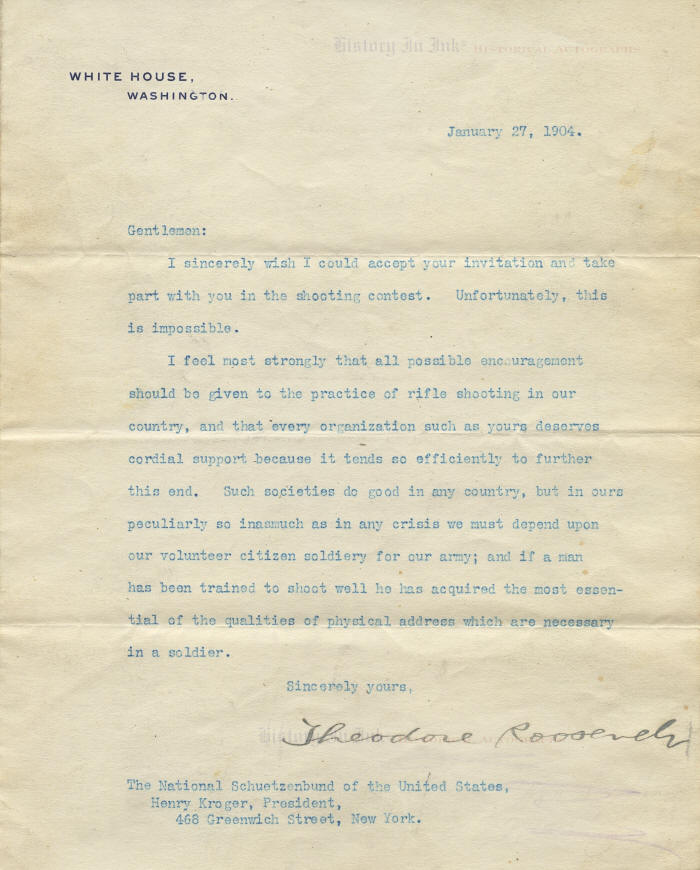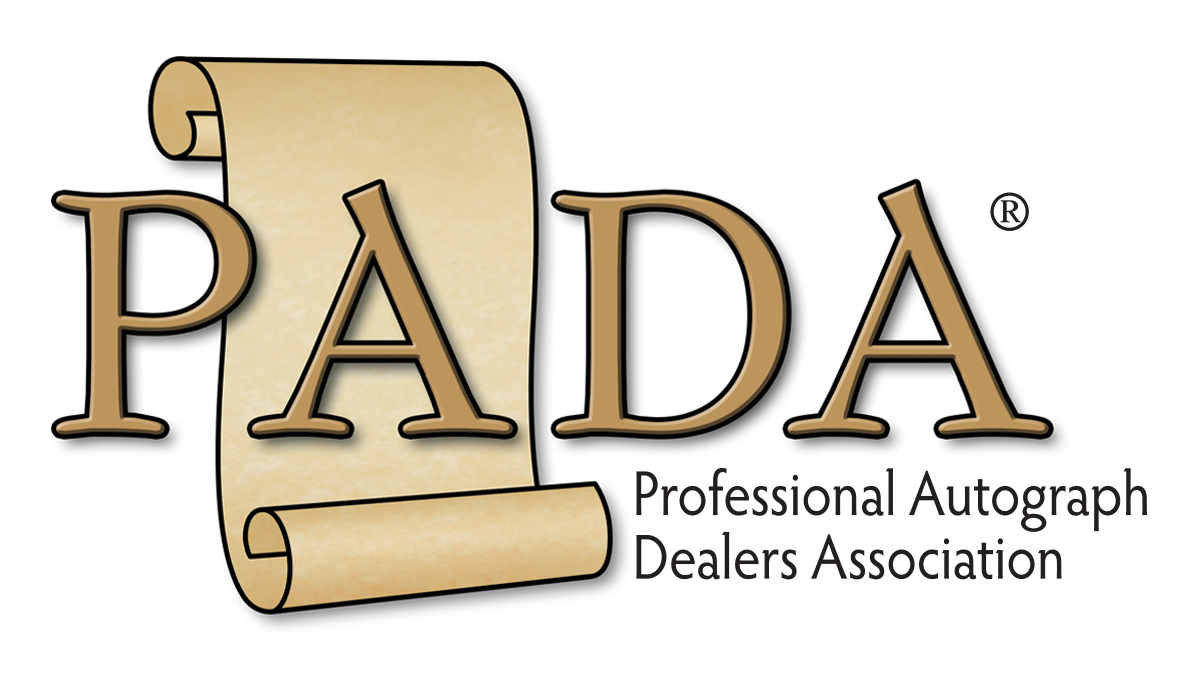2131501
Theodore Roosevelt
Scroll down to see images of the item below the description
“ . . . if a man has been trained to shoot well
he has acquired the most essential of the qualities of physical address
which are necessary in a soldier.”
Theodore Roosevelt, 1858–1919. 26th President of the United States. Typed letter signed, Theodore Roosevelt, one page, 7⅛” x 8⅞”, with integral leaf attached, on engraved stationery of the White House, Washington, [D.C.], January 27, 1904.
In this outstanding letter, President Roosevelt takes a stand that would inflame today’s debate over gun control. An avid outdoorsman and gun enthusiast, Roosevelt expresses his strong views that the practice of rifle shooting should be encouraged and that shooting organizations deserved support because they were important to volunteer militias vital to national defense.
Sending regrets that he could not attend a shooting contest sponsored by The National Schuetzenbund of the United States, the President writes, in full:
I sincerely wish I could accept your invitation and take part with you in the shooting contest. Unfortunately, this is impossible.
I feel most strongly that all possible encouragement should be given to the practice of rifle shooting in our country, and that every organization such as yours deserves cordial support because it tends so efficiently to further this end. Such societies do good in any country, but in ours peculiarly so inasmuch as in any crisis we must depend upon our volunteer citizen soldiery for our army; and if a man has been trained to shoot well he has acquired the most essential of the qualities of physical address which are necessary in a soldier.
Roosevelt likely responds to an invitation to attend the fourth German-American National Shooting Festival, which was held June 12–20, 1904.
Roosevelt returned to the theme of this letter in 1908, in his eighth annual message to Congress—today’s State of the Union message. In it, he lamented that the “great body of our citizens shoot less and less as time goes on.” He urged Congress to “provide a complete plan for organizing the great body of volunteers behind the Regular Army and National Guard when war has come” and to assist “those who are endeavoring to promote rifle practice so that our men, in the services or out of them, may know how to use the rifle.” The government should, he said, “encourage rifle practice among schoolboys, and indeed among all classes, as well as in the military services by every means in our power. Thus, and not otherwise, may we be able to assist in preserving peace in the world. Fit to hold our own against the strong nations of the earth, our voice for peace will carry to the ends of the earth. Unprepared, and therefore unfit, we must sit dumb and helpless to defend ourselves, protect others, or preserve peace. The first step—in the direction of preparation to avert war if possible, and to be fit for war if it should come—is to teach our men to shoot.”
A big game hunter and a member of the National Rifle Association, Roosevelt reportedly owned more guns than any other President. He regularly carried a mother-of-pearl gripped Fabrique National Model 1900 semi-automatic pistol and kept it in his bedside nightstand at the White House. His favorite rifles were Winchesters, which he had used since he special ordered his first two, consecutively serial numbered, in the summer of 1881. He had at least 22 of them. He wrote that the “Winchester stocked and sighted to suit myself is by all odds the best weapon I ever had, and I now use it almost exclusively . . . . [T]he Winchester is the best gun for any game to be found in the United States[.]” Theodore Roosevelt, Hunting Trips of a Ranchman 32–33 (1885). As Governor of New York, he presented a Winchester to General Leonard Wood, who had been his superior in Cuba during the Spanish-American War.
This letter is on stationery that appeared for only a few years. The White House was known as the “Executive Mansion” before Roosevelt’s presidency. Early in his first term, perhaps coinciding with when he stopped using black-bordered mourning stationery headed “Executive Mansion” following the assassination of President William McKinley, Roosevelt changed the stationery to reflect the mansion’s common name, “White House.” That is the name that appears here. Our research shows that Roosevelt used the black-bordered “Executive Mansion” stationery as late as October 16, 1901, and began using stationery headed “White House” by November 1, 1901. With one exception, Roosevelt used the stationery headed “White House” through July 11, 1905. The exception is a handwritten letter dated November 21, 1907, that Roosevelt wrote on evidently leftover “White House” stationery. Otherwise, by at least by October 7, 1905, his letters began to appear on stationery headed “The White House,” which the presidential stationery still uses. Thus it appears that the “White House” stationery on which Roosevelt wrote this letter was in regular use fewer than four years.
Roosevelt has signed this letter with a large, 4” black fountain pen signature. In addition, he has clearly formed the two letters “ve” in “Roosevelt,” which he often did not do. The letter has three horizontal folds, with some soiling and handling. There are light pencil marks before and after the signature, one barely touching the end of the signature, and pencil marks below the signature as though someone had written there and then marked out the writing. None of the marks is particularly obtrusive. Overall the letter is in fine condition.
Unframed.
This item has been sold.
Click here to see more Presidents and First Ladies autographs.







